The Guide to Getting It On (37 page)
Read The Guide to Getting It On Online
Authors: Paul Joannides
Tags: #Self-Help, #Sexual Instruction, #Sexuality

Anyone with testicles can get testicular cancer, but it is more likely to affect younger men, particularly men between the ages of 15 and 35. It is curable 97% of the time if detected early enough. Considering that the testicles are hanging out and easily examined, you would think that it is almost always detected early. But the last thing a guy between the ages of 15 and 35 thinks about is the possibility of getting cancer. After all, cancer is something that happens to people your parents’ age, so it is beyond the average male’s consciousness to check every month for lumps or changes in texture.
Another problem is that a lot of men would rather sit naked on a fencepost than call the doctor’s office and say, “I’m concerned about my testicle, and I’d like you to check it out.” So they wait until the cancer has spread before getting care. This isn’t good, since some forms of testicular cancer can double in size in fewer than thirty days, and you won’t feel a bit of pain as it is happening. It would be easier if cancer of the testicles usually caused pain. If that were the case, most men would go to the doctor immediately. But cancer of the testicle usually doesn’t hurt.
A third roadblock in detecting cancer of the testicles is the extra meaning that we attach to testicles, as in the term “He’s got balls!” On a symbolic level, it’s a big thing when a guy loses a ball. Most of us would rather deny the possibility.
In spite of the way men feel about their own testicles, women are not necessarily enamored by them. In fact, you don’t want to know how some women describe the scrotum on our sex survey. So unless you’ve been caught cheating on them, most women wouldn’t care if you have one testicle or two. They’d want you to be healthy with one testicle rather than dead with two. In fact, some guys who have lost a testicle due to cancer play the cancer card quite effectively. Far from being put off by the idea of a scrotum with only one ball in it, women are sometimes curious.
Cancer of the testicles is one of the few cancers where it is often a partner who discovers the problem. This can be a lifesaver. Hopefully, women readers will learn how to examine their partner’s testicles in the name of health as well as pleasure. They should insist he see a healthcare provider if they find something that’s worrisome.
The most common symptom to look for is a small lump or nodule on the side or sometimes the front of the testicle. It’s usually not painful when you press on it. Another symptom is hardening of the testicle. Mind you, testicles can swell and shrink, but it’s time to get it checked when the entire testicle starts to lose its spongy texture. It’s also important to see a healthcare provider if you are feeling unusual swelling in your scrotum. Less common symptoms include pain or discomfort in the testicles, back pain, swollen breasts (guy breasts), or a feeling of heaviness or unusual discomfort deep in your pelvis.
There are a number of things that can look like cancer of the testicles. One of these is a spermatocele. This is a sperm-filled cyst in the epididymis that feels like a smaller third ball. These are pretty common and usually aren’t a problem unless they get really big. Most of the things you will find in a scrotum besides balls aren’t cancer and can often be treated with antibiotics. So don’t assume that your doctor is going to present you with bad news.
It is wise to do a routine exam once a month. The best time is when the scrotum is warm and saggy, like after a hot shower. Don’t do an exam when you have an erection, as erections can pull your testicles up. The Ball Check chart that follows on the next three frames explains what to do.
The mother of all ball-cancer websites is Doug Bank’s incredible Testicular Cancer Resource Center:
tcrc.acor.org
. See also Chapter 81:
Sex and Breast, Brain & Ball Cancer.
A Note on Self Exams:
While the medical community no longer recommends that men do monthly testicular exams, our cancer-of-the-testicles advisor suggests that men do monthly exams, and that their partners learn to do exams on them as well. If you examine the testicles every month, you, will recognize what’s normal and when there is a change. The problem is when men don’t do the exams monthly and suddenly check their scrotum. They will sometimes freak because they’re not used to what’s there.
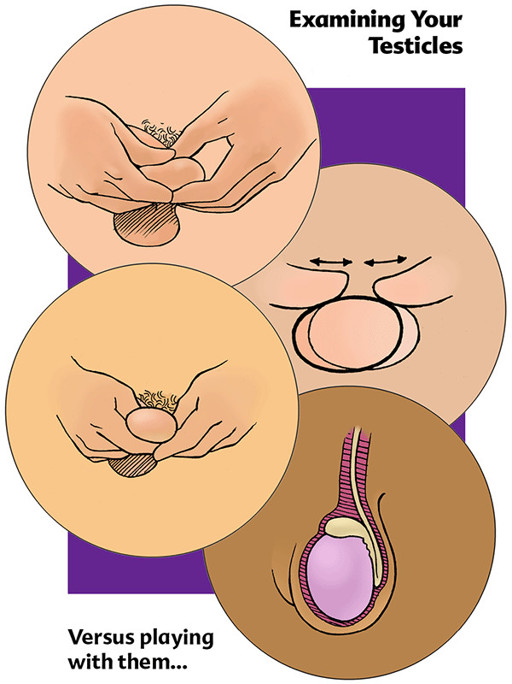
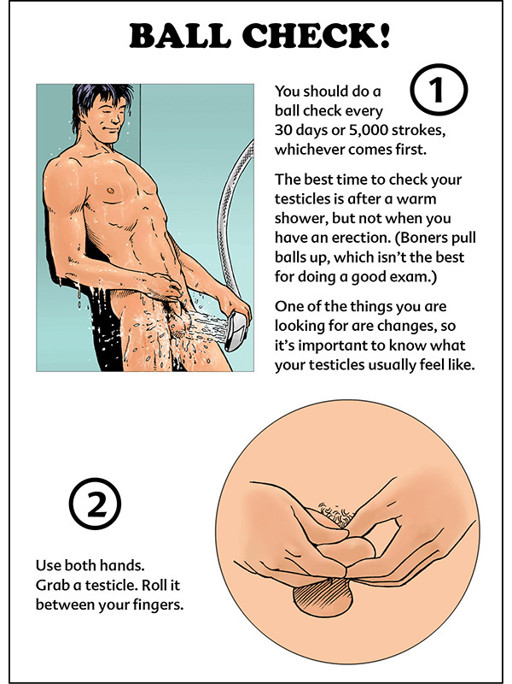
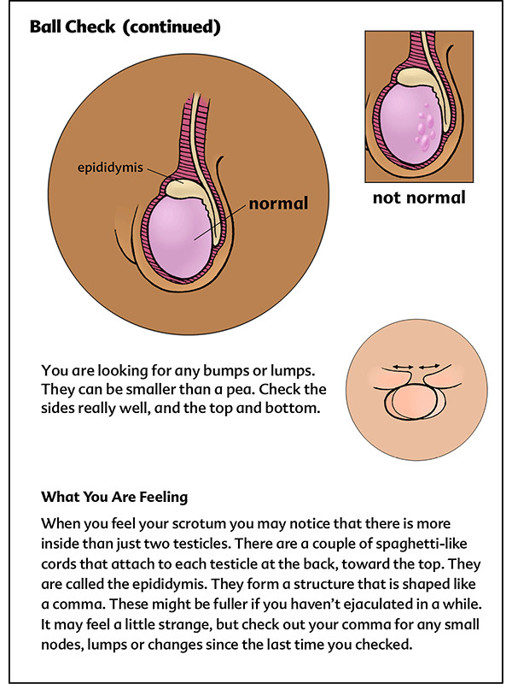
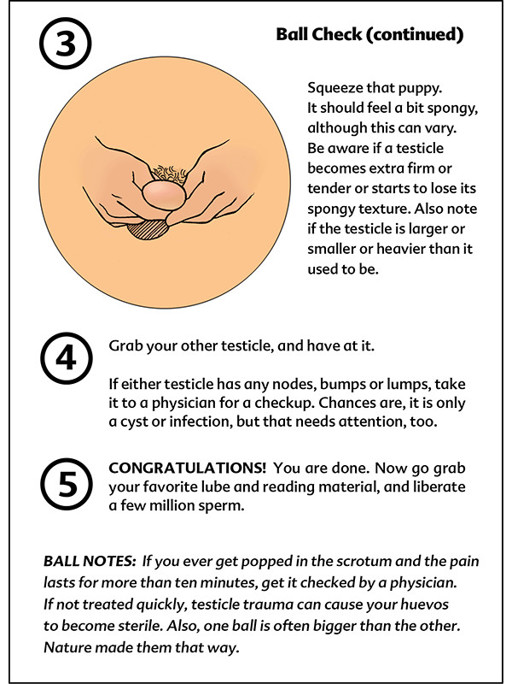
Testicular Torsion
Testicular torsion occurs when the testicle twists in the scrotum, causing the blood vessels in the spermatic cord to twist shut. It is very serious, and if emergency surgery is not performed within four to six hours, it is quite possible that the testicle will be lost. This is why any sudden or acute pain in the testicles that lasts for more than ten minutes should result in an immediate trip to the emergency room. The same is true for an excruciating pain that appears for a few minutes and then suddenly stops. Don’t take a wait and see attitude, as it might be too late if you gambled wrong.
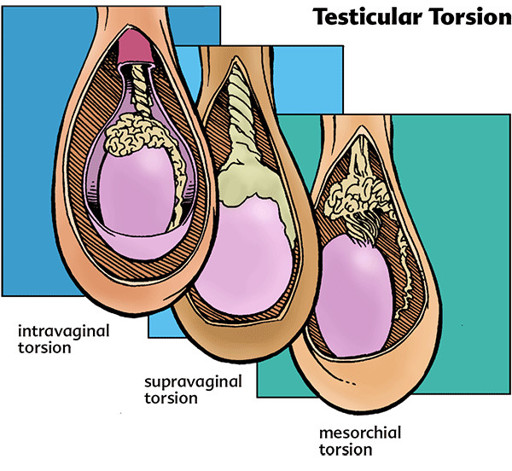
Torsion happens more often in teenagers, but adult males can get it as well. The potential for torsion is created when the testicle is not properly anchored in the scrotum. The three most common types of testicular torsion are illustrated above.

CHAPTER
18
The Prostate & The Male Pelvic Underground
O
ne of the truly cool things about the prostate is that it is completely hidden. It is the one sex organ a guy doesn’t have to worry about the size of when he’s naked at the gym or when he is with a new lover. Prostates are measured in grams instead of inches, and a man has to be pretty neurotic before he’d worry about how his prostate stacks up against another guy’s. In fact, you would have to be chewing on some seriously strong mushrooms before you would ever hear one young woman say to another, “You won’t believe the size of Bobby’s prostate!”
Like the prostate, the seminal vesicles are important sex glands that are tucked inside a man’s pelvis, but you don’t hear as much about them because they rarely give a guy a hard time. The seminal vesicles sit on top of the prostate like a pair of rabbit ears on a 1960s television. They make up about 70% of semen. Without seminal vesicles and a prostate, ejaculation would be a non-event. The wad would be a no-show.
This chapter tackles a range of prostate and seminal-vesicle matters. It provides the skinny on the two sex glands that are involved when a guy launches his load—and they are not his testicles.

The Prostate in Ancient Greek Mythology
You’ve probably heard how Zeus was the head of the Gods on Mount Olympus, and how he was a jealous man with paranoid tendencies. What you probably don’t know is how the prostate gland came to be. To make a long story short, there was a rather peculiar god by the name of Prostateus whose saliva smelled like chlorine bleach. Zeus feared that Prostateus was scheming to overthrow him, so he asked his wife Hera to land Prostateus in the underworld near the River Styx. Hera didn’t get the message quite right. She thought Zeus said to make Prostateus a gland by the river of shit.
